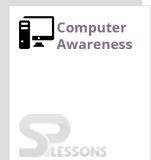 Introduction
Introduction
A computer system consists of two major elements: Computer Software and Hardware. Computer hardware is the collection of all the parts you can physically touch. Computer software, Software is a set of instructions for a computer to perform specific operations.
 Concepts
Concepts
CPU is the main component of the computer. CPU is divided into three major parts.
Hardware peripherals of computer
The peripheral devices connect to the computer to extend the features and to extend the functionality of the devices. Examples are a mouse, keyboard, monitor, printer, and scanner.
Input devices
Input devices are used to give instructions to the computer to perform the operations. Examples of input devices are a mouse and a keyboard.
Output devices
Output devices are used to see the results of the input which is given by the user. Examples of output devices are monitor and a printer
Storage devices
Storage devices are used to store the information and data. Examples of storage devices are the hard drive, pen drives, DVDs, CDs etc.
- Control Unit
- Arithmetic Logic Unit
- Memory
Control unit
This unit controls the operations of all parts of a computer. It obtains the instructions from the memory, interprets them, and directs the operation of the computer. CPU communicates with Input/output devices for transfer of data or results from storage and it does not process or store data.
- It controls all units of computer when data is entered by keyboard, it saves the instructions given by user and send to the ALU to further process.
- It converts the user input and coverts them into signals sends ALU.
- It uses clock inputs to maintain the sequence of the data, this speed is the frequency of the data processing and it is measured in Megahertz.
Arithmetic Logic Unit
An arithmetic-logic unit (ALU) is the part of a computer processor (CPU) that carries out arithmetic and logic operations. Modern CPUs contain very powerful and complex ALUs. In addition to ALUs, modern CPUs contain a control unit (CU).
- An ALU performs basic arithmetic, examples of arithmetic operations are addition, subtraction, multiplication, and division.
- It also performs logical operations like comparisons of values such as NOT, AND, and OR.
- All information in a computer is stored in the form of binary numbers, i.e. 0 and 1.
- All arithmetic operations are carried out by using the gates. There are many types of gates are there NOR, AND, NOT, OR and etc.
- ALU splits complex operations into simple operations to perform the task easily.
| Input | Output | ||||||
|---|---|---|---|---|---|---|---|
| A | B | AND | NAND | OR | NOR | EXOR | ENOR |
| 0 | 0 | 0 | 1 | 0 | 1 | 0 | 1 |
| 0 | 1 | 0 | 1 | 1 | 0 | 1 | 0 |
| 1 | 0 | 0 | 1 | 1 | 0 | 1 | 0 |
| 1 | 1 | 1 | 0 | 1 | 0 | 0 | 1 |
Memory Unit
The memory unit stores the data, instructions and sends the information to all the other units of the computer whenever it needs. It is also known as primary memory or main memory or RAM (Random access memory) or internal storage unit. All input and output are transmitted through main memory.
Primary Memory
It is also called as the main memory of the computer. It stores the instructions, operating system and data which required to run the computer. Examples of primary memory are RAM.
Secondary Memory
Secondary storage, sometimes called auxiliary storage or external storage, is storage. It is not volatile memory and is not directly accessed by the computer. We can store the data in this longer period until we format the data it will be available.
Secondary memory consists of all permanent storage devices like read-only memory (ROM), flash drives, hard disk drives (HDD), magnetic tapes and other types of internal/external storage devices
- Secondary memory is slower than primary memory but can store and retain data whenever user needs.
- User can store huge amount of data ranging from megabytes to several terabytes of storage space within a single memory.
- User can carry these devices in anywhere and can connect to any device.
 Questions
Questions
1. Which one of these holds RAM, ROM, and extension cards?
- Hard disk
- D-ROM
- Floppy disk
- Motherboard
- Primary memory
- Secondary memory
- Random access
- Read only memory
- Data
- Program
- Results
- All the above
- an optical ROM
- an erasable ROM
- a magnetic ROM
- None of the above
- 4.5"
- 3”
- 5”
- 4.2”
- Vertically
- Horizontally
- Internally
- Diagonally
- data bus
- control bus
- address bus
- multiplexed bus
- Hard disk
- CD-ROM
- Floppy disk
- Motherboard
- Keyboard
- Internet Explorer
- Trackball
- Scanner
- control unit
- arithmetic and logic unit
- the main store
- all of above
- RAM
- ROM
- CPU
- CD_ROM
- Sound Card
- Video Card
- Mouse
- Joy Stick
- 7
- 8
- 9
- 2
- Electrical charge
- Magnetic field
- Ultraviolet rays
- None of the above
- SRAM
- DRAM
- DRDRAM
- RAM
- Primary memory
- Secondary memory
- RAM
- ROM
- AC
- DC
- Both A and B
- None of the above
- Floppy disk
- CD
- DVD
- Motherboard
- FlASH memory
- Catch memory
- Both A&B
- None of the above
- Data bus
- Control bus
- Address bus
- Multiplexed bus




